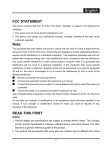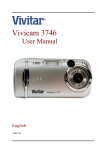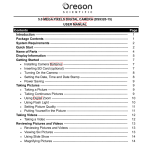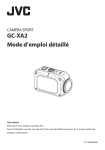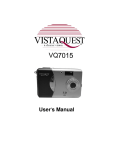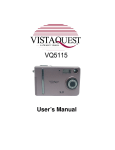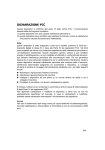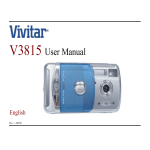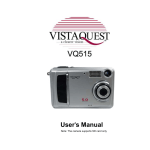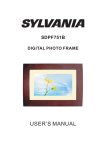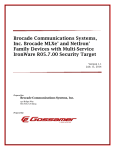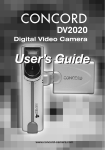Download Vivitar ViviCam 3750 Digital Camera
Transcript
V3750 User Manual English 041020TP FCC STATEMENT This device complies with Part 15 of the FCC Rules. Operation is subject to the following two conditions: (1) This device may not cause harmful interference, and (2) This device must accept any interference received, including interference that may cause undesired operation Note: This equipment has been tested and found to comply with the limits for Class B digital devices, pursuant to Part 15 of the FCC rules. These limits are designed to provide reasonable protection against harmful interference in a residential installation. This equipment generates, uses and can radiate radio frequency energy and, if not installed and used in accordance with the instructions, may cause harmful interference to radio communications. However, there is no guarantee that interference will not occur in a particular installation. If this equipment does cause harmful interference to radio or television reception, which can be determined by turning the equipment off and on, the user is encouraged to try to correct the interference by one or more of the following measures: Reorient or relocate the receiving antenna Increase the separation between the equipment and receiver Connect the equipment into an outlet on a circuit different from that to which the receiver is connected Consult the dealer or an experienced radio/TV technician for help Use of shielded cable is required to comply with Class B limits in Subpart B of Part 15 of the FCC rules. Do not make any changes or modifications to the equipment unless otherwise specified in the manual. If such changes or modifications should be made, you could be required to stop operation of the equipment. EN-1 TRADEMARK INFORMATION Microsoft® and Windows® are U.S. registered trademarks of Microsoft Corporation. Pentium ® is a registered trademark of Intel Corporation. Macintosh is a trademark of Apple Computer, Inc. SDTM and MMCTM are trademarks. Other names and products may be trademarks or registered trademarks of their re spective owners. READ THIS FIRST Notice: 1. Product design and specifications are subject to change without notice. This includes primary product specifications, software, software drivers, and user's manual. This User Manual is a general reference guide for the product. 2. The product and accessories that come with your camera may be different from those described in this manual. This is due to the fact that different retailers often specify slightly different product inclusions and accessories to suit their market requirements, customer demographics, and geographical preferences. Products very often vary between retailers especially with accessories such as batteries, chargers, AC adapters, memory cards, cables, carrying cases/pouches, and language support. Occasionally a retailer will specify a unique product color, appearance, and internal memory capacity. Contact your dealer for precise product definition and included accessories. 3. The manufacturer assumes no liability for any errors or discrepancies in this user's manual. 4. For driver updates and revisions to this manual, please refer to our website. EN-2 WARNINGS Do not use this camera if it is emitting smoke (or an unusual odor), if it becomes unusually hot to the touch, produces a peculiar noise, or exhibits any other abnormal conditions. Operating the camera in any of these circumstances may cause a fire or an electrical shock. Stop using the camera immediately, turn the camera off and remove the batteries. Contact your dealer or authorized service facility for repairs. Never attempt to repair this camera by yourself, as this may be dangerous. Do not expose the camera to moisture and make sure no water gets into the camera. Take particular care when using the camera under extreme weather conditions, such as rain or snow, or when operating the camera at the beach or near water. Avoid using this camera in places subject to extreme moisture. Do not use the camera if water has entered the camera. Turn the camera off and remove the batteries. Contact your dealer or authorized service facility. Do not continue to use the camera as this may cause a fire or an electrical shock. Do not use the camera if any foreign objects have entered the camera. Turn the camera off and remove the batteries. Contact your dealer or authorized service facility. Do not continue to use the camera as this may cause a fire or an electrical shock. Do not place the camera in an unstable location such as on a wobbly table or sloping surface where the camera may fall or tip over and cause injury. If the camera has been dropped or damaged, turn the camera off and remove the batteries. Contact your dealer or authorized service facility. Do not continue to use the camera as this may cause a fire or an electrical shock. Do not insert or drop metallic or other foreign objects into the camera through access points such as the memory card slot. This may cause a fire or an electrical shock. Do not attempt to modify this camera. Do not remove the camera casing. This may cause a fire or an electrical shock. Internal inspection and repairs should only be carried out by an authorized service facility. Never operate this camera in any way while driving a vehicle. This may cause a traffic accident. EN-3 CAUTIONS Do not place this camera in a location affected by oil fumes or steam, such as near a cooking stove or humidifier. This may cause a fire or an electrical shock. Do not leave this camera in a location subject to extremely high temperatures, such as in a sealed vehicle or in direct sunlight. Exposure to high temperatures may adversely affect the camera case and internal components and may cause a fire. Do not cover or wrap the camera with a cloth or quilt. This may cause heat to build up and distort the camera case and cause a fire. Always use the camera and accessories in well-ventilated locations. Handle the camera carefully and do not expose the camera to shock or vibration. Handling the camera roughly may cause a malfunction. Do not use batteries other than those specified for use with your camera. Use of unsuitable batteries may result in the batteries splitting, or leaking and may cause a fire, injury, or soiling of the battery compartment. When placing the batteries into the camera, check the polarity markings on the batteries ( - and + ) to ensure that the batteries are inserted correctly. Incorrect battery polarity will result in camera inoperability and may result in the batteries splitting or leaking and causing a fire, injury, or soiling of the battery compartment. Remove the batteries if the camera will not be used for an extended period of time. The batteries may leak and cause a fire, injury or soiling of the battery compartment. If the batteries leak, clean and wipe the battery compartment carefully and install new batteries. Wash your hands carefully if you touch the battery fluid. WARNING: Handling the USB and AV cables on this product may expose you to lead, a chemical known to the State of California to cause birth defects or other reproductive harm. Wash hands after handling. EN-4 CONTENTS INTRODUCTION Overview .................................................................................................. 8 Package Contents .................................................................................. 9 GETTING TO KNOW YOUR VIVICAM 3750 Features ................................................................................................. 11 LCD Monitor Icons ................................................................................ 12 GETTING STARTED Installing Batteries ................................................................................ 14 Inserting an SD Memory Card (optional accessory) ............................. 15 Attaching the Hand Strap ....................................................................... 16 Setting the Date and Time .................................................................... 16 Setting Image Resolution and Quality .................................................. 17 RECORD MODE Capturing Images ................................................................................. 19 Portrait Focus ........................................................................................ 19 Normal Focus ....................................................................................... 20 Digital Zoom ......................................................................................... 20 Self-Timer ............................................................................................. 21 Flash ..................................................................................................... 22 EN-5 PLAYBACK MODE Viewing Images .................................................................................... 24 Zoom Playback ...................................................................................... 25 Displaying Thumbnail Images ............................................................. 26 Slideshow Display ............................................................................... 26 Deleting Images ................................................................................... 27 MOVIE MODE Recording Video Clips .......................................................................... 29 Viewing Video Clips .............................................................................. 30 TRANSFERRING RECORDED IMAGES AND VIDEOS TO YOUR COMPUTER Step 1: Install the USB Mass-Storage Driver ........................................ 32 Step 2: Connecting the ViviCam 3750 to Your Computer .................... 33 Step 3: Downloading Image and Video Files ....................................... 34 INSTALLING PHOTOSUITE..........................................................35 INSTALLING PHOTOVISTA..........................................................36 INSTALLING ACROBAT READER.................................................37 USER’S MANUAL ON CD-ROM....................................................38 USING THE VIVICAM 3750 AS A PC CAMERA Step 1: Install the PC Camera Driver .................................................... 40 EN-6 Step 2: Connecting the ViviCam 3750 to Your Computer .................... 40 Step 3: Running Your Application Software .......................................... 41 MENU OPTIONS Record Menu ......................................................................................... 42 SETUP MENU .......................................................................................................... 42 EV & WHITE BALANCE ........................................................................................... 43 Movie Menu ........................................................................................... 44 Playback Menu ...................................................................................... 45 SETUP MENU .......................................................................................................... 45 SLIDE SHOW .......................................................................................................... 45 ERASE ..................................................................................................................... 45 COPY TO CARD ..................................................................................................... 45 Setup Menu ........................................................................................... 46 LCD BRIGHTNESS .................................................................................................. 46 DATE/TIME ............................................................................................................... 46 LANGUAGE .............................................................................................................. 46 SOUND........................................................................................................47 FORMAT MEDIA ....................................................................................................... 47 VIDEO MODE .......................................................................................................... 47 AUTO POWER OFF ................................................................................................ 47 LIGHT FREQUENCY ............................................................................................... 48 FACTORY SETUP ................................................................................................... 48 CONNECTING THE VIVICAM 3750 TO OTHER DEVICES .............. 49 VIVICAM 3750 SPECIFICATIONS ................................................... 50 EN-7 INTRODUCTION Overview Your new digital ViviCam 3750 delivers high quality images using a 3.1 Mega pixel sensor. Using the TFT color image LCD monitor, you can compose images and then examine them in detail. A auto-flash sensor automatically detects the shooting (lighting) conditions and determines whether the flash should be used. This feature helps ensure that your images turn out right. Internal (built-in) memory lets you capture and store images without the need for an additional memory card. However, you may wish to expand the memory capacity (up to 512MB capacity) by using an external memory card. In addition to still images, you can record short videos using the movie function. Images you have taken can be downloaded to your computer using the USB cable (A USB driver required for Win 98) You can enhance and retouch your images on your computer by using the provided editing software, or image editing software you may already own. You may share your images with your friends via e-mail, in a report, or on a website. EN-8 Package Contents Carefully unpack your ViviCam 3750 and ensure that you have the following items: Common Product Components: Digital Camera USB cable Video cable 2 x AA alkaline batteries Software CD-ROM User's manual Camera strap Common (Optional) Accessories: Memory card Camera pouch Note: The accessories that come with your ViviCam 3750 may be different from those described in this manual due to the fact that different retailers often specify slightly different product inclusions and accessories to suit their market requirements, customer demographics, and geographical preferences. Products very often vary between retailers especially with accessories such as batteries, chargers, AC adapters, memory cards, cables, carrying cases/pouches, and language support. Occasionally a retailer will specify a unique product color, appearance, and internal memory capacity. Contact your dealer for precise product definition and included accessories. EN-9 GETTING TO KNOW YOUR VIVICAM 3750 1 EN-10 Features 1. Shutter button 2. Focus dial 3. 4. 5. 6. 7. 8. 9. Portrait focus Normal focus Flash Lens Hand strap eyelet VIDEO OUT jack USB connector Self-timer LED LED indicator 10. LCD monitor 11. Arrow button (up) Quality/Resolution button Display button Arrow button (left) Self-timer button 13. OK OK button ZOOM Digital zoom button 12. 14. Arrow button (right) 15. Flash button Arrow button (down) Delete button 16. Power button 17. Mode button 18. Menu button 19. Battery/Memory card cover 20. Tripod socket EN-11 LCD Monitor Icons Display icons - Still Image Record Mode: 1. Record mode 2. Battery level 6. White balance [no indication] Auto Tungsten Fluorescent 1 Full battery power Medium battery power Low battery power Virtually no battery power 3. Flash mode Automatic flash Automatic with Red-eye reduction Flash off 4. Focus mode [no indication] Normal focus Portrait focus 5. Self-timer mode Fluorescent 2 Cloudy Daylight 7. EV compensation (no indication with 0EV) 8. Possible number of shots remaining (at the current size and quality settings) 9. Image resolution and quality 10.Digital zoom 11. Memory card indicator SD memory card MultiMediaCard (MMC) EN-12 Display icons - Movie Mode: 1. Movie mode 2. Battery level 3. Recordable movie time available 4. Memory card indicator 5. EV compensation 6. White balance 7. Recording indicator (blinking) Display icons - Still-Image Playback Mode: 1. Playback mode 2. Battery level 3. Frame number 4. Memory card indicator Display icons - Video (movie) Playback Mode: 1. Playback mode 2. Battery level 3. Frame number 4. Recorded movie time 5. The first frame of the movie 6. Memory card indicator 7. Playback indicator EN-13 GETTING STARTED You can use 2 AA size batteries (Alkaline, Ni-MH) to power the camera. Installing Batteries 1. 2. 3. 4. Make sure the camera is turned off. Slide the battery/memory card cover in the direction of the [OPEN] arrow. Insert the batteries, noting correct polarity (+ and -). Close the battery/memory card cover firmly. Note: If you will not be using the batteries for an extended period of time, remove them from the camera to prevent leakage or corrosion. Never use manganese batteries. Never use batteries of different types (together) or mix old and new batteries. Avoid using batteries in extremely cold environments as low temperatures can shorten the battery life and reduce camera performance. When the icon appears on the LCD monitor, the LED indicator will blink for 5 seconds and then the camera will automatically power off. Replace the exhausted batteries with a new set of batteries. EN-14 Inserting an SD Memory Card (optional accessory) The ViviCam 3750 comes with internal memory, allowing you to store images and video clips in the camera. However, you can expand the memory capacity by using an optional SD (Secure Digital) memory card so that you can store additional images and video clips. 1. Make sure the camera is turned off. 2. Slide the battery/memory card cover in the direction of the [OPEN] arrow. 3. Insert an SD memory card: The front side of the memory card (printed arrow) should face towards the front side of the camera. If the card cannot be inserted, check the orientation. This ViviCam 3750 is also compatible with the MultiMediaCardTM. 4. Close the battery/memory card cover. To remove a memory card: Make sure the camera is turned off. Open the battery/memory card cover. Press lightly on the edge of the memory card and it will eject. Note: To prevent valuable data from being accidentally erased from an SD memory card you can slide the write protect tab (on the side of the SD memory card) to "LOCK". To save, edit, or erase data on an SD memory card, you must unlock the card. EN-15 Attaching the Hand Strap To prevent accidental dropping of the ViviCam 3750, always use the strap. Attach the hand strap as follows: 1. Thread the small loop of the hand strap through the hand strap eyelet on the camera. 2. Pull the large loop through the small loop until the strap is firmly secured. ME RA Setting the Date and Time The DATE/TIME screen will be presented if/when: Camera is turned on for the first time. Camera is turned on after leaving the camera without batteries for an extended period of time. When the DATE/TIME screen appears, follow these steps to set the correct date and time. Select the year, month, day, and time fields by using the / button. Press the OK button after all fields are set. To increase a value, press the To decrease a value, press the button. button. EN-16 Setting Image Resolution and Quality Resolution and quality settings determine the pixel size (dimension), image file size, and compression ratio for your images. These settings affect the number of images that can be stored in memory, or on a memory card. As you get to know the ViviCam 3750, it is recommended that you try each quality and resolution setting to get an appreciation for the effects that these settings will have on your images. Higher resolution and higher quality images offer the best photographic results but produce large files sizes. Therefore, few images will take up a lot of memory space. High resolution and quality settings are recommended for printed output and situations requiring the finest detail. Lower resolution/quality images take up less memory space and may be quite suitable for sharing images via e-mail, in a report, or on a web page. To change image resolution or image quality, perform these steps below: 1. Power on the camera. (If already on, toggle the MODE button to the mode.) 2. Toggle the 2048F button to select the image size or image quality you prefer. 2048N 1600 1280 EN-17 This table shows the approximate number of images that you can store at each setting in 16MB internal memory or using an optional memory card from 8MB to 512MB: * The above data shows the standard testing results. The actual capacity varies according to the shooting conditions and setting. Note that the ViviCam 3750 has 16MB of internal memory of which 14MB can be used for image storage. EN-18 RECORD MODE Capturing Images Your ViviCam 3750 is equipped with a color LCD monitor to compose images. 1. Turn the camera on by pressing the power button. (The ViviCam 3750 will always power-up in still-image record mode.) button to the 2. If not in record mode, toggle the mode. 3. Compose your shot on the display screen. 4. Press the shutter button. Note: The LCD monitor does not work well under direct sunlight and bright light. Portrait Focus Capturing images by selecting the portrait focus setting will produce an image with a sharp subject and indistinct background. The effective range of focus is between 3 and 5 feet. 1. Power on the camera. Make sure the camera is in Record mode. 2. Set the focus dial located on the front side of the camera to the position. The icon appears on the LCD monitor. 3. Compose your scene. 4. Press the shutter button. Note: The flash mode is disabled in the portrait focus setting. EN-19 Normal Focus The normal focus setting, suitable for scenery shooting, is used when the distance to the subject is greater than 5 feet. 1. Power on the camera. Make sure the camera is in Record mode. 2. Set the focus dial located on the front side of the camera to the position. 3. Compose your scene. 4. Press the shutter button. Digital Zoom Using digital zoom, images appear closer. Whereas digital zoom is a compelling feature, the more an image is enlarged (zoomed), the more pixilated (grainier) the image will appear. 1. Power on the camera. Make sure the camera is in Record mode. 2. Press the OK button to activate the digital zoom function. The zoom bar and magnifier icon appear on the LCD monitor. Press the button to magnify up to 4X. Press the button to reduce the magnification level. 3. Press the OK button to cancel the digital zoom function. 4. Press the shutter button to capture a "zoomed" image. Note: The more the image is enlarged, the more pixilated (grainier) the image. EN-20 Self-Timer The self-timer duration is ten seconds. Activate the self-timer by pressing the shutter button. The self-timer LED blinks slowly for seven seconds and then blinks rapidly for the last three seconds. This allows you to get into the scene when capturing group images. 1. Secure the camera to a tripod or place it on a stable surface. 2. Power on the camera. Make sure the camera is in Record mode. 3. Press the button. The icon appears on the LCD monitor. 4. Compose the scene. 5. Press the shutter button. The self-timer function is activated. 6. After ten seconds, the camera takes an image. To cancel the self-timer at any time, press the shutter button to disrupt the sequence. Note: After an image is taken using self-timer, the self-timer mode is turned off. If you wish to take another image using the self-timer, repeat these steps. EN-21 Flash The flash is designed to function automatically when lighting conditions warrant the use of flash. You can capture an image using a flash mode suitable to your circumstances. If you change the flash mode, the camera will retain that setting even if the camera is turned off. 1. Power on the camera. Make sure the camera is in Record mode. 2. Press the button repeatedly until the desired flash mode appears. 3. Compose the image and press the shutter button. Note: If you will not be using the flash, turn it off. Turning the flash OFF will result in faster camera startup and faster operation because the capacitor will not be charged needlessly. Turning the flash OFF when not needed, will also improve battery life. Flash mode is disabled during portrait focus setting to avoid over-exposed photos. EN-22 The ViviCam 3750 has three flash modes: Automatic Flash (default), Automatic with Red-eye reduction and Flash Off. The modes appear, cyclically, when you press the button. The table below will help you choose the appropriate flash mode: Flash mode Automatic flash Description The flash fires automatically according to the ambient lighting conditions. Select this mode for general flash photography. The flash emits a precursor-flash before the main flash fires. Automatic with This Red-eye reduction causes the pupil in the human eye to Red-eye reduction constrict, reducing the red-eye phenomenon. Select this mode when capturing images of people and animals in low-light conditions. Flash off The flash will not fire. Select this mode when capturing images in a place where flash photography is prohibited, or when the distance to the subject is beyond the effective range of the flash. Note: The Flash mode is disabled when the portrait focus setting is used. EN-23 PLAYBACK MODE In the mode, you can view, magnify, delete images, play video clips, or run a slide show. Playback mode also provides a thumbnail image display, allowing you to quickly search for the image you want. Viewing Images 1. Power on the camera and toggle the the mode. 2. View your images using the / button to button. To view the previous image, press the To view the next image, press the button. button. Press the button (same as the / button) once to display the detailed image information such as image quality & size, time and date. Note: If there are no images stored in memory, the "NO IMAGES" message will appear on the LCD monitor. You can also view your images on the TV screen. First connect one end of the video cable to the VIDEO OUT jack of the ViviCam 3750. Then connect the other end to the video input jack of the TV. Toggle the button to the mode and then the TV and camera on. EN-24 Zoom Playback While reviewing your images, you may enlarge a selected portion of an image. This magnification allows you to view fine details. 1. Power on the camera, and toggle the button to the mode. 2. Select the image that you want to view using the / button. 3. Enlarge the image by pressing the ZOOM button (the OK button). Pressing the ZOOM button once magnifies the image to 2X. Pressing it again magnifies the image to 3X 4X. 4. To view the different portion of the enlarged image, press the / / / button. 5. To return to the regular display (cancel playback zoom) from 4X-enlarged status, press the ZOOM button again. EN-25 Displaying Thumbnail Images This function allows you to view as many as nine thumbnail images on the LCD monitor simultaneously so you may search for a particular image. 1. Power on the camera, and toggle the button to the mode. 2. Toggle the button until the thumbnail screen appears. Nine thumbnail images appear on the LCD monitor (assuming there are nine or more images in memory). To view a full-size image, selecting it by using the / / / button, and then press the OK button and the selected image will be displayed in the full LCD frame. Slideshow Display The slideshow function enables you to playback your images back automatically in sequential order as a slide show. This is a very useful and entertaining feature for reviewing recorded images and for presentations. 1. Power on the camera, and toggle the button to the mode. 2. Press the button and move to SLIDE SHOW by using the / button. 3. Set the playback interval by using the / button and press the OK button. The slideshow starts, displaying your images on the LCD monitor, one by one, at the set interval. To stop the slideshow display, press the OK button. Note: You can adjust the slideshow display interval from 1 to 9 seconds ([1 SEC], [3 SEC], [5 SEC], [7 SEC], [9 SEC]). EN-26 Deleting Images You can delete an image or video clip or all images and video clips at once by using the Erase function in the Playback menu. To delete one image or video clip: 1. Press the button and move to ERASE by using the / button. 2. Select ERASE ONE by using the / button and press the OK button. 3. When the delete message appears, select the image/ video clip you wish to delete by using the / button. To delete the selected image/video clip, use the button to select [YES], and press the OK button. The next image/video clip appears. To cancel the deletion, select [NO] and press the OK button. It will return to the playback mode. 4. Continue deletions, as desired. If all images are deleted, the "NO IMAGES" message will be displayed. Note: In the / (same as the / mode, you can also delete one image or video clip by pressing the button). EN-27 button To delete all images or video clips (at once): 1. Press the button and move to ERASE by using the 2. Select ERASE ALL by using the / / button. button and press the OK button. ERASE ALL menu appears on the screen. 3. Select [YES] by using the / button and press the OK button to delete all images. The "NO IMAGES" message appears because all images and video clips have been deleted. To exit from this screen, press either the or button. Note: To delete images or videos stored in internal memory, do not insert a memory card into the camera. Otherwise, you will delete the images or video clips stored on the memory card. EN-28 MOVIE MODE Recording Video Clips The movie mode allows you to record video clips at a resolution of 320 x 240 pixels. 1. Power on the camera, and toggle the button to the mode. The amount of time available for movie recording is displayed on the LCD monitor. (The time format is Minutes: Seconds) 2. To start recording a video clip press (and release) the shutter button. The elapsed time is displayed and the recording indicator ( ) blinks on the LCD monitor while recording. To stop recording, press the shutter button again. Notes about Movie Mode: Resolution is always 320 x 240 and image quality cannot be specified. The self-timer cannot be used. The flash mode is disabled. Movie clips are silent - without audio. EN-29 Viewing Video Clips To view a recorded video clip, follow these steps: 1. Power on the camera, and toggle the button to the 2. Select the video clip you wish to view using the / mode. button. 3. Press the OK button to start. To pause playback at any time, press the OK button. * Press the OK button again to resume playback. To exit this movie playback and return to the playback mode, press the button. Notes about Video Playback: The zoom function cannot be activated during movie playback. To play the video clip back on your computer, you may use either Windows Media Player or Apple "QuickTime Player". QuickTime basic player is available free of charge, compatible with both Mac- and Windowscomputers and can be download from the Apple web site at www.apple.com. For help using QuickTime Player usage, please refer to the QuickTime on-line help for more information. EN-30 TRANSFERRING RECORDED IMAGES AND VIDEOS TO YOUR COMPUTER To transfer images/video clips from the camera to your computer, follow these steps: Step 1: Install the USB mass-storage driver (Windows 98 only) Step 2: Connecting the ViviCam 3750 to your computer Step 3: Downloading image and video files System Requirements (Windows) Pentium 200 MHz or higher Windows 98/98SE/Me/2000/XP 128MB RAM 40MB hard disk space CD-ROM drive Available USB port System Requirements (Macintosh) PowerPC G3/G4 OS X or later 128MB RAM 40MB hard disk space CD-ROM drive Available USB port EN-31 Step 1: Install the USB Mass-Storage Driver Windows 98 computers The USB mass-storage driver on the CD-ROM is required for Windows 98 computers. Installing the USB mass-storage driver on computers running Windows 2000/ME/XP is not necessary for downloading images. (Note however a video driver is required if you wish to use the live-video feature.) 1. Insert the CD-ROM that came with the ViviCam 3750 into your CD-ROM drive. The welcome screen appears. 2. Click “DRIVER”. Follow the on-screen instructions to complete the installation. After the USB driver has been installed, restart your computer. Macintosh OS X computers For Mac OS X or higher, the computer will automatically recognize the ViviCam 3750 and load its own USB drivers. EN-32 Step 2: Connecting the ViviCam 3750 to Your Computer 1. Connect one end of the USB cable to an available USB port on your computer. 2. Connect the other end of the USB cable to the USB connector on the camera. 3. The USB MODE menu appears on the screen. 4. Use the / button to select DISK DRIVE, and press the OK button. DISK DRIVE is displayed on the LCD monitor. 5. From the Windows desktop, double click on “My Computer”. 6. Look for a new “removable disk” icon.This “removable disk” is actually the memory (or memory card) in your camera. Typically, the camera will be assigned drive letter “e” or higher. 7. Double click on the removable disk and locate the DCIM folder. 8. Double click on the DCIM folder to open it to find more folders. Your recorded images and video clips will be inside these folders. Copy & Paste or Drag-N-Drop image and video files to a folder on your computer. Mac users: Double-click the “untitled” disk drive icon on our desktop. iPhoto may automatically launch. The volume label may vary depending upon whether you use internal camera memory, or a memory card. Note: When transferring images to the computer, there is no need to install any batteries into the ViviCam 3750. The camera will automatically power on when connected to the computer via USB cable. EN-33 Step 3: Downloading Image and Video Files When the camera is turned on and connected to your computer, it is considered to be a disk drive, just like a floppy disk or CD. You can download (transfer) images by copying them from the “removable disk” (“untitled” disk on a Macintosh) to your computer hard drive. Windows Open the “removable disk” and subsequent folders by double clicking on them. Your images are inside these folder(s). Select the images that you want, then choose “Copy” from the “Edit” menu. Open the destination location (folder) and choose “Paste” from the “Edit” menu. You may also drag and drop image files from the camera to a desired location. Macintosh Open the “untitled” disk icon, and the destination location on your hard disk. Drag and drop from the camera to the desired destination. Note: Memory card users may prefer to use a memory card reader (highly recommended). EN-34 INSTALLING PHOTOSUITE PC users will find that PhotoSuite is a very user-friendly image-editing program. With PhotoSuite, you can retouch, compose, and organize your images. It includes a variety of templates, such as photo frames, birthday cards, calendars and more. Get your images ready and explore this amazing program. To install PhotoSuite: 1. Insert the CD-ROM that came with the ViviCam 3750 into your CD-ROM drive. The welcome screen appears. 2. Click “PHOTO SUITE”. Follow the on-screen instructions to complete the installation. Note: To use PhotoSuite to edit and retouch your recorded images, please refer to the on-line help. For Windows 2000/XP users, please make sure to install and use the PhotoSuite in "Administrator" mode. PhotoSuite is not supported on the Mac. iPhoto or iPhoto2 is recommended. EN-35 INSTALLING PHOTOVISTA PC users will find that PhotoVista is an easy-to-use program that lets you create spectacular 3600 panoramic images in a snap. When you view these panoramas, you get the experience of being totally immersed in a realistic environment. PhotoVista's powerful engine quickly and automatically stitches images together, and its intuitive interface will let even a novice get great results in minutes. To install PhotoVista: 1. Insert the CD-ROM that came with the ViviCam 3750 into your CD-ROM drive. The welcome screen appears. 2. Click “PHOTO VISTA”. Follow the on-screen instructions to complete the installation. Note: To use PhotoVista to create spectacular 3600 panoramic images, please refer to the on-line help for this software. For Windows 2000/XP users, please make sure to install and use the PhotoVista in "Administrator" mode. PhotoVista is not supported on the Mac. Windows XP users who have not installed XP Service Pack 1, be sure to link to http://www.java.com/ en/download/windows_automatic.jsp first and download the Java Virtual Machine installation. For more information about Java, please refer to its on-line help at http://java.sun.com/getjava/help.html After this Java installation, you can install iSee Media PhotoVista. PhotoVista System Requirements are: * Windows 98, Windows NT 4 (Service Pack 3 or higher) * Windows 2000, Windows Me, Windows XP Service Pack 1 or higher EN-36 INSTALLING ACROBAT READER The CD-ROM includes a PDF (portable document format) copy of the user’s manual. To view a PDF you must have Acrobat Reader installed in your computer. Acrobat Reader is included on the camera CD-ROM. Using Acrobat Reader, you can read the user’s manual and print sections of interest. 1. Insert the CD-ROM that came with the ViviCam 3750 into the CD-ROM drive. The welcome screen appears 2. Click “Adobe Acrobat Reader”. Follow the on-screen instructions to complete the installation. For Mac users: 1. Insert the CD-ROM that came with the ViviCam 3750 into the CD-ROM drive. 2. Select and double-click “Acrobat Reader”. 3. Select and double-click the language that you want. 4. Double-click “Reader Installer”. Follow the on-screen instructions to complete the installation. EN-37 USER’S MANUAL ON CD-ROM A copy of the user’s manual on is provided on the CD-ROM in PDF format. It is a backup copy of the printed manual. If you misplace the printed guide, you may print another copy from the CD-ROM. The only requirement for viewing the User Manual on the CDROM is that you have Acrobat Reader installed on your computer. Updates to this manual, and versions in other languages may be found on our website. 1. Insert the CD-ROM that came with the ViviCam 3750 into the CD-ROM drive. The welcome screen appears. 2. Click “Instruction Manual”. Follow the on-screen instructions to complete the installation. Alternatively, browse the CD-ROM to find the PDF file. For Mac users: 1. Insert the CD-ROM that came with the ViviCam 3750 into the CD-ROM drive. 2. Select and double-click “Manual”. 3. Select and double-click the language that you want. 4. Drag and drop the PDF file from the current location to the destination location. View the user’s manual by opening it. EN-38 USING THE VIVICAM 3750 AS A PC CAMERA Your ViviCam 3750 can act as a PC camera, which allows you to videoconference with business associates, or have a real-time conversation with friends or family. To use the ViviCam 3750 as a PC camera, follow these steps: Step 1: Install the PC camera driver (it is combined with the USB mass-storage driver on the CD-ROM) Step 2: Connecting the ViviCam 3750 to your computer Step 3: Running your application software (i.e. Windows NetMeeting) Note: Video conferencing (or video editing) software is not included with the ViviCam 3750. This mode is not supported for Mac. General System Requirements for Videoconferencing To use the ViviCam 3750 for videoconferencing, your computer system must include: Microphone Sound card Speakers or headphones Network or Internet connection EN-39 Step 1: Install the PC Camera Driver The PC-camera driver included on the CD-ROM is exclusively for Windows. The PC camera function is not supported for Mac platforms. 1. Insert the CD-ROM that came with the ViviCam 3750 into your CD-ROM drive. The welcome screen appears. 2. Click “DRIVER”. Follow the on-screen instructions to complete the installation. After the driver installation is completed, restart your computer. Note: The USB driver that bundled inside the CD-ROM is designed in a form 2 in 1 (USB & PC camera driver). a) On Windows 98, the Windows OS will install both USB mass-storage & PC camera drivers. b) On Windows 2000/ME/XP, it will only install PC camera driver. Step 2: Connecting the ViviCam 3750 to Your Computer 1. 2. 3. 4. Connect one end of the USB cable to an available USB port on your computer. Connect the other end of the USB cable to the USB connector on the camera. The USB MODE menu appears on the screen. Use the / button to select PC CAMERA, and press the OK button. PC CAMERA is displayed on the LCD monitor. 5. Position the camera steadily on top of your computer monitor or use a tripod. Note: When using ViviCam 3750 as a PC camera, there is no need to install any batteries into the camera. The camera will automatically power on when connected to the computer via USB cable. EN-40 Step 3: Running Your Application Software (i.e. Windows NetMeeting) To use Windows NetMeeting for videoconferencing: 1. Go to Start Programs Accessories Communications NetMeeting to launch the NetMeeting program. 2. Click the Start Video button to view live video. 3. Click the Place Call button. 4. Type the e-mail address or the network address of the computer that you are calling. 5. Click Call. The person that you are calling must also have Windows NetMeeting running and be willing accept your call to start the videoconference. Note: The video resolution for videoconferencing applications is generally 320 x 240. For more information about the operation of videoconference application software, refer to its respective help documentation. EN-41 MENU OPTIONS Record Menu You can use the Record menu to adjust exposure and white balance. You can also access the Setup menu in the Record menu. To access the Record menu, toggle the button to the mode and press the button. Scroll through the menu options by using the / button. SETUP MENU Press the OK button to access the Setup Menu. For more information about Setup Menu, refer to the Setup menu section. EN-42 EV & WHITE BALANCE Exposure (EV) Your ViviCam 3750 adjusts the exposure of each scene automatically. However, if the subject is very dark, or very bright, you may override the camera's automatic exposure determination to make the subject brighter or darker. This is called EV compensation. The EV compensation can be adjusted from -2.0EV to +2.0EV. To select the EV compensation you wish, press the OK button. Then, use the / button to select the EV compensation you desire, and press the OK button. Examples of Exposure Compensation Positive (+) Compensation Imaging printed text (black characters on white paper) Portraiture with back lighting Very bright scenes (such as snow) and highly reflective subjects Shots made up predominantly of sky Negative (-) Compensation Spot lighted subjects, particularly against dark backgrounds Imaging of printed text (white characters on black paper) Scenes with low reflectivity, such as shots of green or dark foliage EN-43 White Balance Your ViviCam 3750 adjusts the white balance of each scene automatically. However, the images that your camera captures will appear different under different lighting conditions (daylight, cloudy, fluorescent, tungsten lights). Unlike your eyes, which can easily adjust to different lighting conditions (lighting temperatures), a digital camera cannot always differentiate between lighting types. Under some lighting conditions the image may appear in strange shades. If that occurs you may change the white balance setting by specifying a lighting condition (temperature) most appropriate for your scene. To set the white balance, press the OK button. Then select the appropriate white balance by using the / button, and press the OK button. [ ]: Camera automatically adjusts white balance [ ]: For tungsten lighting AUTO [ ]: For reddish fluorescent lighting [ ]: For bluish fluorescent lighting [ ]: For cloudy and shady sky [ ]: For outdoors on a bright day Movie Menu To adjust movie settings, press the button in the mode and navigate to the option you wish to set by using the / button. For more information about Exposure (EV) and White balance, refer to the Record menu section. And for more information about Setup Menu, refer to the Setup menu section. EN-44 Playback Menu Use the playback menu to create an on-camera slide show or transfer images from internal memory to a memory card. You can also use the Playback menu to delete one or all images. To access the playback menu, press the button in the mode and navigate through the options by using the / button. SETUP MENU Press the OK button to access the Setup Menu. For more information about Setup Menu, refer to the Setup menu section. SLIDE SHOW Refer to section in this manual titled "Slideshow Display" in the PLAYBACK MODE for further details. ERASE Refer to section in this manual titled "Deleting Images" in the PLAYBACK MODE for further details. COPY TO CARD This feature allows you to copy your images from the camera's internal memory to a memory card. Of course, you can only do this if you have a memory card installed and some images in internal memory. To perform this function, use the / button to select [COPY] and then press the OK button. EN-45 Setup Menu Select your general camera preferences in the Setup mode. Navigate to the option you wish to configure by using the / button. LCD BRIGHTNESS This option adjusts the brightness of the LCD monitor. To adjust the LCD brightness, you may increase or decrease the LCD brightness by using the / button. DATE/TIME After removing the batteries from the camera, the date and time may return to the default settings. If this happens, reset the date and time when using the camera. Refer to section in this manual titled "Setting the Date and Time" for further details. LANGUAGE This option allows you to select the language for the menus and the text displayed on the LCD monitor. Select the desired OSD language by using the EN-46 / button. SOUND The ViviCam 3750 produces a sound (beep) each time you press a camera button, if this function is enabled. Select [ON] or [OFF] by using the / button. FORMAT MEDIA This utility formats the internal memory (or memory card) and erases all stored images and data. To perform the format function, select [FORMAT] by using the / button and press the OK button. The FORMAT MEDIA menu appears on the screen. Formatting is an irreversible action and data can not be recovered at a later time. Select [YES] by using the / button and press the OK button. VIDEO MODE This utility sets the video output format for displaying recorded images on a television. Select [NTSC] or [PAL] by using the / button. AUTO POWER OFF If there is no camera activity (no buttons are pressed) for a defined period of time while the camera is powered on, the camera will eventually turn itself off to conserve power. You can change the power saving interval by pressing the / button to select the desired interval time. [I MIN], [3 MIN], [5 MIN], [10 MIN], [OFF] EN-47 LIGHT FREQUENCY This ViviCam 3750 supports different lighting frequencies: 50Hz and 60Hz. When photographing under fluorescent lighting, select the correct frequency setting depending on your local area's voltage. This function is only effective if you set the White Balance to or (Fluorescent) setting. Select [50HZ] or [60HZ] by using the / button. FACTORY SETUP If you wish to restore all camera settings to their original status, select [SETUP] by using the / button and then press the OK button. The FACTORY SETUP menu appears on the screen. Select [YES] by using the / button and then press the OK button. EN-48 CONNECTING THE VIVICAM 3750 TO OTHER DEVICES EN-49 VIVICAM 3750 SPECIFICATIONS Item Sensor Image resolution Description Approx. 3.1 Mega pixels 2048(F/N): 2048 x 1536 pixels 1600: 1600 x 1200 pixels 1280: 1280 x 960 pixels LCD Self-timer Zoom Capture modes Memory type Approx. 1.5" color TFT LCD 10-second delay 4X digital zoom Still Image, Video (movie) recording (without audio) 16MB internal memory (14MB available for image storage) SD memory card, MMC (optional, up to 512MB capacity) Fixed focal length: 7.7 mm F-number: 3.5 Normal focus: 5 feet to infinity Portrait focus: 3 to 5 feet Automatic exposure with manual EV compensation +/- 2.0EV in 0.5EV steps Automatic with presets for Tungsten, Fluorescent1, Fluorescent2, Cloudy, Daylight Lens Range of Focus Exposure and Compensation White balance EN-50 Shutter Speed Files formats File standards Interface (Ports) Power Dimensions 1/15~1/1000 sec. JPEG, AVI (Motion JPEG) for video clip JPEG, EXIF 2.1, M-JPEG VIDEO OUT jack, USB connector 2 AA Alkaline (1.5V) or Ni-MH (1.5V) batteries 3.3" x 2.4" x 1.2" (84.2 x 61.4 x 30.8 mm) (W x H x D) (exclusive of protruding features) Weight Approx. 4 ounces (110g) without batteries and memory card *Design and specifications are subject to change without notice. EN-51




















































